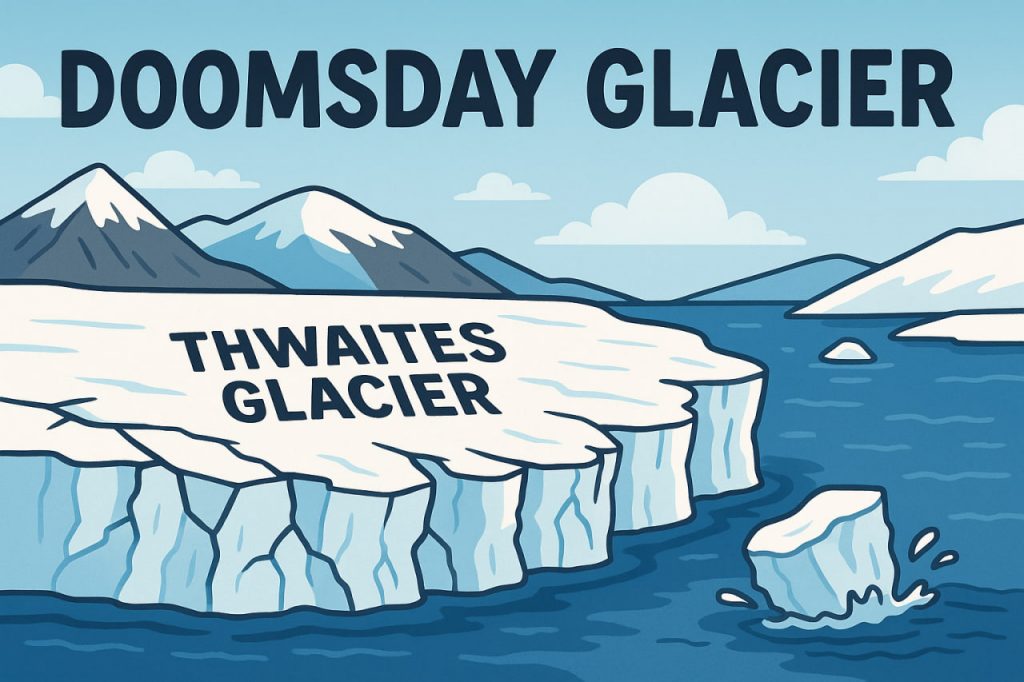Nicknamed the “Doomsday Glacier,” Thwaites Glacier in West Antarctica has captured global attention due to its potential to raise sea levels dramatically if it collapses. This massive glacier, roughly the size of Great Britain or Florida, is melting at an alarming rate, and scientists are racing to understand what could happen next — and how fast.
What Is Thwaites Glacier?
Thwaites Glacier is one of the largest and most unstable glaciers on Earth. It flows into the Amundsen Sea in West Antarctica and holds enough ice to raise global sea levels by more than 60 centimeters (2 feet). But its collapse could trigger the destabilization of neighboring glaciers, potentially leading to several meters of sea-level rise over centuries.
What makes Thwaites particularly dangerous is that much of its ice sits on bedrock below sea level, making it especially vulnerable to warming ocean water that can melt it from underneath.
Why Is It Called the “Doomsday” Glacier?
The name “Doomsday Glacier” reflects its worst-case scenario potential — not because it will end the world, but because its rapid melting could:
- Cause massive coastal flooding worldwide.
- Displace tens of millions of people.
- Disrupt global agriculture and economies.
Thwaites acts like a “plug” for West Antarctica. If it fails, other glaciers behind it could accelerate into the ocean, magnifying the effect.
What’s Happening Now?
Satellite data and research missions have revealed:
- Rapid ice thinning and retreat, especially in the past two decades.
- Melting at the grounding line, where the glacier lifts off the bedrock and begins to float.
- Warm ocean water reaching under the glacier due to shifting ocean currents.
- Cracks and fractures appearing across its ice shelf, weakening its structural integrity.
In 2020, scientists drilled through the ice and measured water temperatures under Thwaites — and found it was above freezing, melting the glacier from below.
Global Consequences of a Collapse
If Thwaites collapses, the resulting sea-level rise would be devastating:
- Coastal cities like New York, London, Mumbai, and Shanghai could face permanent flooding.
- Small island nations may become uninhabitable.
- Ecosystems such as wetlands and estuaries could be lost.
- Economic impacts would include trillions in infrastructure damage and forced migration.
Even partial melting is already causing measurable sea-level rise — and the pace is quickening.
Can the Collapse Be Stopped?
Thwaites is past a critical tipping point, according to some studies, meaning full collapse may be inevitable over centuries. However, slowing the process is still possible:
- Reducing greenhouse gas emissions remains the top global priority.
- Limiting global warming to 1.5°C may preserve ice shelves longer.
- Scientific projects are studying ways to predict future behavior and model collapse scenarios to improve preparedness.
The glacier is being intensely studied by an international effort known as the International Thwaites Glacier Collaboration.
Glossary
- Thwaites Glacier — A large, fast-moving glacier in West Antarctica known for its instability and sea-level impact.
- Ice shelf — A floating extension of a glacier that slows the flow of ice into the ocean.
- Grounding line — The place where a glacier starts to float on the ocean; crucial for its stability.
- Sea-level rise — The increase in the global ocean level due to melting ice and thermal expansion.


